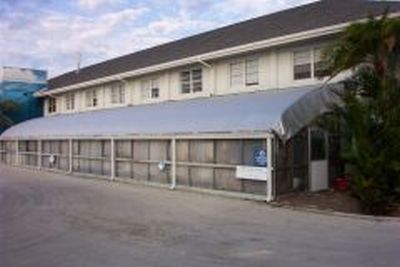
Mote's
aquaculture program was originally located at Mote's main campus
on City Island, a barrier island at the edge of Sarasota
Bay. Now the primary location for our aquaculture research is
located inland at Mote Aquaculture Park in eastern Sarasota County. While
Mote Aquaculture Park's seawater filtration systems are being constructed, the
marine aquaculture program is conducting its high salinity aquaculture
projects at Mote's main campus. These facilities are supporting larval rearing, certain species of nursery and
broodstock fish, and live feeds (rotifers, algae, etc.).
|
Larval and Nursery Fish
Culture Systems
|
Larval Rearing The marine aquaculture program is culturing common snook and pompano from fertilized eggs. These eggs, as well as the newly hatched larvae, need a high salinity environment in order to develop properly. Both of these species can tolerate lower salinities after they have metamorphosed to the juvenile stage. This happens at approximately 20-30 days after hatch. Nursery Rearing Following the larval stage, the nursery rearing phase begins for marine fishes and invertebrates. Our juvenile conch and red snapper nursery culture requires a high salinity environment. These species are cultured at the main campus. |
|
Live Feeds
Culture Systems
|
Live Feeds Culture Live feeds culture at the main campus consists of rotifer and artemia rearing. Although the rotifers and artemia may not be cultured at high salinities, current techniques used create a large amount of effluent water. This waste water can be easily filtered through perculation ponds on Mote's main campus. The live feeds culture work is also located on the main campus because the marine larval culture efforts are located at Mote's main campus. The rotifer culture systems consist of both batch and recirculating systems that are fed an algae paste diet. |
Broodstock Maturation and Spawning The broodstock systems allow the marine aquaculture staff to simulate natural environmental conditions in order to induce spawning behavior. Typically, broodstock are collected from local marine coastal systems and brought back to the laboratory for captive spawning. Spawning is either induced by hormone injection or by temperature and photoperiod manipulation . We are currently conducting maturation and spawning research with Florida pompano in these systems. These fish are collected from high salinity environments, and are stocked and maintained in high salinity tanks. The main campus has four 35,750 liter tanks (9445.4 gallons) that are used for broodstock. These broodstock spawn floating eggs that are passively skimmed off the top of the water with a skimming bar. This bar then directs the eggs to a separate egg collecting tank positioned adjacent to the brooder tanks. There are two brooder tanks on each filtration system. Each filtration system consist of a sump, bead filter, fluidized bed, protein skimmer, ultra-violet sterilizer, and heater/chiller unit. These filtration systems are located outside of the maturation room in order to minimize both heat and noise. The tanks are in an insulated room with an automated lighting system and water heating/chilling unit. This setup allows the marine aquaculture staff to simulate natural environmental conditions in order to induce spawning behaviors. |
Broodstock
Maturation and Spawning Systems
Broodstock Filtration Systems |


Back to
Mote
Back to CARD
Main
Page
Main Page